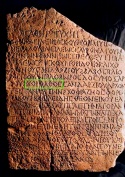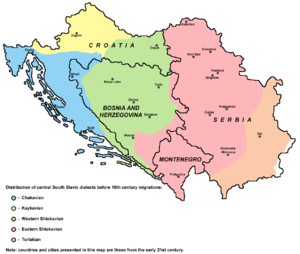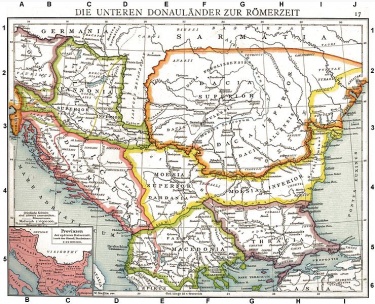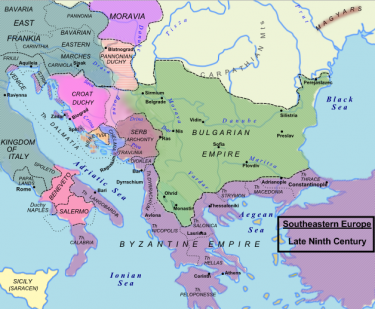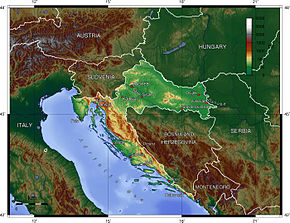Difference between revisions of "Croatian Identity"
(→Medieval Croatia: rv) |
m (mv) |
||
| (One intermediate revision by the same user not shown) | |||
| Line 23: | Line 23: | ||
Slavic tribes invaded the region of [[Dalmatian Italians#Roman Dalmatia |Roman Dalmatia]] in the early Middle Ages. Contemporary historian Danijel Dzino states that the 19 century theories of mass movements of people into the old Roman Province of Dalmatia are '''questionable'''. Modern Archaeological and Scholarly research seems to be saying that we are looking at much smaller groups of Slavs invading the region. According to historians ''Florin Curta'' and Danijel Dzino the term Slavs was first used by outside observers of the day (Greco-Roman) to describe the newcomers. The Slavs used the term to describe themselves at a '''later stage'''. Thus began the '''construct''' identity of the new arrivals. Later the Slavic peoples started to identify themselves and separated (or were separated by others) into different groups. There was also a good deal of interaction between the groups as shown by DNA studies. | Slavic tribes invaded the region of [[Dalmatian Italians#Roman Dalmatia |Roman Dalmatia]] in the early Middle Ages. Contemporary historian Danijel Dzino states that the 19 century theories of mass movements of people into the old Roman Province of Dalmatia are '''questionable'''. Modern Archaeological and Scholarly research seems to be saying that we are looking at much smaller groups of Slavs invading the region. According to historians ''Florin Curta'' and Danijel Dzino the term Slavs was first used by outside observers of the day (Greco-Roman) to describe the newcomers. The Slavs used the term to describe themselves at a '''later stage'''. Thus began the '''construct''' identity of the new arrivals. Later the Slavic peoples started to identify themselves and separated (or were separated by others) into different groups. There was also a good deal of interaction between the groups as shown by DNA studies. | ||
| − | + | ||
The issue of dates is an interesting one. Historians from the 18th and 19th century place the ''settlement'' of the Slavs into the Western Balkans in the 7th century but the more modern research undertaken by scholars and archaeologists<ref>[http://books.google.com.au/books?id=6UbOtJcF8rQC&pg=PA52&dq=croatian+graves+medieval+dalmatian+dating&hl=en&ei=LA6HTan-IsGHcYbf3Y4D&sa=X&oi=book_result&ct=result&resnum=1&ved=0CD4Q6AEwAA#v=onepage&q&f=false Becoming Slav, Becoming Croat:] Identity Transformations in Post-Roman and Early Medieval Dalmatia by Danijel Dzino (p52).</ref> cannot confirm this. The settlement of the Slavs in small groups has now been thought to be more in the region of the 8th century .<ref>Historians of this school of thought are D. Dzino, L.Margetic, Ancic, Rapanic and V.Sokol.</ref> The early sources must have reflected the '''raid''' and mercenary activity of the Slavic tribes within Roman Dalmatia. Also there are no '''contemporary''' written records about the invasion/migration/settlement, about the events as a whole ''and'' the area itself. | The issue of dates is an interesting one. Historians from the 18th and 19th century place the ''settlement'' of the Slavs into the Western Balkans in the 7th century but the more modern research undertaken by scholars and archaeologists<ref>[http://books.google.com.au/books?id=6UbOtJcF8rQC&pg=PA52&dq=croatian+graves+medieval+dalmatian+dating&hl=en&ei=LA6HTan-IsGHcYbf3Y4D&sa=X&oi=book_result&ct=result&resnum=1&ved=0CD4Q6AEwAA#v=onepage&q&f=false Becoming Slav, Becoming Croat:] Identity Transformations in Post-Roman and Early Medieval Dalmatia by Danijel Dzino (p52).</ref> cannot confirm this. The settlement of the Slavs in small groups has now been thought to be more in the region of the 8th century .<ref>Historians of this school of thought are D. Dzino, L.Margetic, Ancic, Rapanic and V.Sokol.</ref> The early sources must have reflected the '''raid''' and mercenary activity of the Slavic tribes within Roman Dalmatia. Also there are no '''contemporary''' written records about the invasion/migration/settlement, about the events as a whole ''and'' the area itself. | ||
The Baska tablet from 1100 AD records that they spoke old Slavic Chakavian (listen). [http://www.croatianhistory.net/glagoljica/baska.mp3 Baska tablet-mp3] <ref>Note ''Baska tablet'' was translated in 1875, it's language is Old Slavic Croatian Chakavian with elements of liturgical Church Slavonic.</ref> | The Baska tablet from 1100 AD records that they spoke old Slavic Chakavian (listen). [http://www.croatianhistory.net/glagoljica/baska.mp3 Baska tablet-mp3] <ref>Note ''Baska tablet'' was translated in 1875, it's language is Old Slavic Croatian Chakavian with elements of liturgical Church Slavonic.</ref> | ||
| − | + | [[File:800px-Bascanska ploca.jpg|thumb|right|350px|Baska tablet 1100 AD from Baska, on the island of Krk-[[Croatia]].]] | |
=Editor's Note= | =Editor's Note= | ||
'''Duke Branimir''' from the 880s, spoke old Croatian Slavic (Chakavian) and was from the Dalmatian hinterland. Mr Branimir is, I believe the first Croatian ''or'' the first Southern Slav to describe himself as a Croatian. In my opinion his tribe, who were the old Slavic Chakavian speakers, are the first recorded Croatians (recorded as such and based on the current records that we have the ''Harvat tribe'', modern: Hrvati <ref>It is believed that Hrvat in medieval times was pronounced "'''Harvat'''" or Hrovat. It was translated to Latin: Chroatorum and then simplified to Croatorum.</ref>). We can safely assume that Branimir's tribe goes back a few generations, especially since they had their own language i.e. Old Croatian Chakavian. | '''Duke Branimir''' from the 880s, spoke old Croatian Slavic (Chakavian) and was from the Dalmatian hinterland. Mr Branimir is, I believe the first Croatian ''or'' the first Southern Slav to describe himself as a Croatian. In my opinion his tribe, who were the old Slavic Chakavian speakers, are the first recorded Croatians (recorded as such and based on the current records that we have the ''Harvat tribe'', modern: Hrvati <ref>It is believed that Hrvat in medieval times was pronounced "'''Harvat'''" or Hrovat. It was translated to Latin: Chroatorum and then simplified to Croatorum.</ref>). We can safely assume that Branimir's tribe goes back a few generations, especially since they had their own language i.e. Old Croatian Chakavian. | ||
| Line 33: | Line 33: | ||
The early medieval Western Balkans must have had multiple small Slavic ethnic tribes. In some cases the newly arrived Slavs lived amongst the population that was there prior to their arrival. It is my opinion that for whatever reason it appears that their history has not been recorded accurately ''or'' not recorded at all (it evolved into frontier country, 'borderland'). | The early medieval Western Balkans must have had multiple small Slavic ethnic tribes. In some cases the newly arrived Slavs lived amongst the population that was there prior to their arrival. It is my opinion that for whatever reason it appears that their history has not been recorded accurately ''or'' not recorded at all (it evolved into frontier country, 'borderland'). | ||
| − | From a Greco-Roman perspective they were all identified as Slavs. Most probably based on rough linguistic-language classification. The Slavs found themselves living in a '''medieval multi-ethnic''' region; Roman Latin-Illyrian population as well as Liburnians, Greeks, Guduscani | + | From a Greco-Roman perspective they were all identified as Slavs. Most probably based on rough linguistic-language classification. The Slavs found themselves living in a '''medieval multi-ethnic''' region; Roman Latin-Illyrian population as well as Liburnians, Greeks, Guduscani, Ostrogoths and others. It has been mention that there is a possibility that further back in time other ethnic groups were within the Slavic tribes. This could explain the Persian (Sarmatian) connection. |
It was the most powerful chieftains (the main political players) who left a '''mark''' on history. Taking this into account, over a period of time in the middle ages we have new '''political identities''' of Southern Slavs emerging (regionally based ''or'' names brought with them). Among these were Croatians, Narentines, Bulgarians<ref>Bulgarians also have a strong historic association with Turkic semi-nomadic tribes. It has been written that in early medieval times the Bulgar elite spoke a language that was a member of the Turkic language group. </ref>, Bosnians, Serbs (Raška) etc. | It was the most powerful chieftains (the main political players) who left a '''mark''' on history. Taking this into account, over a period of time in the middle ages we have new '''political identities''' of Southern Slavs emerging (regionally based ''or'' names brought with them). Among these were Croatians, Narentines, Bulgarians<ref>Bulgarians also have a strong historic association with Turkic semi-nomadic tribes. It has been written that in early medieval times the Bulgar elite spoke a language that was a member of the Turkic language group. </ref>, Bosnians, Serbs (Raška) etc. | ||
Latest revision as of 08:19, 6 December 2024
The first factual primary source, to mention the Croatian (Hrvat) identity was that of Duke Branimir (written in Latin: "Branimiro comite dux cruatorum cogitavit" c. 880 AD). [1] Duke Branimir was a Slav from Dalmatia.
- Dr Danijel Dzino of Macquarie University, Sydney Australia writes:
The Terms Slav and Croatian
Slav as a term was first used by the Byzantine's - Eastern Roman Empire (i.e. Procopius, Byzantine scholar, 6th century Roman bureaucrat) and was recorded in the 6th century (events cia. 518 [3]) in Greek: Σκλαβῖνοι (Sklabenoi or sklaboi). Later in Latin, Sklabenoi was written Sclaveni. Ancient Roman [4] and Greek communities also referred to the early Slavic peoples as Veneti and Antes.
Raid activity by various Slavic tribes within the southern Danube region started in the 6th century.
Hrvat is a word of Sarmatian (Persian) origins. [5] In 1853 a Russian archaeologist Pavel Mikhailovich Leontjev discovered the Tanais Tablets. The Tanais Tablets mention three men: Horoúathos, Horoáthos, and Horóathos (Χορούαθ[ος], Χοροάθος, Χορόαθος). They are written in Greek and are from the 3rd century AD from the city of Tanais, today's Azov, Russia. At that time the region had mainly a mix of Greek - Sarmatian population.
Contact Between Slavic and Sarmatian Tribes
From the information above one can conclude that we are dealing with contact between Slavic and Sarmatian tribes from late antiquity. From a modern day perspective the Sarmatian historical footprint is non existent. All traces of these people have disappeared other than Slavic terms surrounding the word or name Hrvat (through etymology) which translates to English as Croat. Radoslav Katicich (Katičić) a Croatian linguist (and a classical philologist, Indo-Europeanist, Slavist and Indologist) said that the names from the Tanais Tablet are personal and not national ones.[6] Furthermore it also could be said that these names are not related to any ethnic identity. Historically the term Croat became fully established as a constructed identity in the 19th century.
Recent DNA Studies
It is also very interesting to note that recent DNA studies have stated that more than three quarters of today's Croatian men are the descendants of Europeans who inhabited Europe 13 000-20 000 years ago.[7] From a DNA studies perspective, the peoples who were living in Roman Dalmatia (prior to the arrival of Slavic tribes) were genetically dominant and remain so to this day. The peoples who were living in Roman Dalmatia in that period predominately were of an Illyrian population. [8]
Settlement of the Slavs in Roman Dalmatia
Slavic tribes invaded the region of Roman Dalmatia in the early Middle Ages. Contemporary historian Danijel Dzino states that the 19 century theories of mass movements of people into the old Roman Province of Dalmatia are questionable. Modern Archaeological and Scholarly research seems to be saying that we are looking at much smaller groups of Slavs invading the region. According to historians Florin Curta and Danijel Dzino the term Slavs was first used by outside observers of the day (Greco-Roman) to describe the newcomers. The Slavs used the term to describe themselves at a later stage. Thus began the construct identity of the new arrivals. Later the Slavic peoples started to identify themselves and separated (or were separated by others) into different groups. There was also a good deal of interaction between the groups as shown by DNA studies.
The issue of dates is an interesting one. Historians from the 18th and 19th century place the settlement of the Slavs into the Western Balkans in the 7th century but the more modern research undertaken by scholars and archaeologists[9] cannot confirm this. The settlement of the Slavs in small groups has now been thought to be more in the region of the 8th century .[10] The early sources must have reflected the raid and mercenary activity of the Slavic tribes within Roman Dalmatia. Also there are no contemporary written records about the invasion/migration/settlement, about the events as a whole and the area itself.
The Baska tablet from 1100 AD records that they spoke old Slavic Chakavian (listen). Baska tablet-mp3 [11]
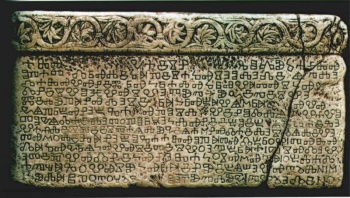
Editor's Note
Duke Branimir from the 880s, spoke old Croatian Slavic (Chakavian) and was from the Dalmatian hinterland. Mr Branimir is, I believe the first Croatian or the first Southern Slav to describe himself as a Croatian. In my opinion his tribe, who were the old Slavic Chakavian speakers, are the first recorded Croatians (recorded as such and based on the current records that we have the Harvat tribe, modern: Hrvati [12]). We can safely assume that Branimir's tribe goes back a few generations, especially since they had their own language i.e. Old Croatian Chakavian.
The early medieval Western Balkans must have had multiple small Slavic ethnic tribes. In some cases the newly arrived Slavs lived amongst the population that was there prior to their arrival. It is my opinion that for whatever reason it appears that their history has not been recorded accurately or not recorded at all (it evolved into frontier country, 'borderland').
From a Greco-Roman perspective they were all identified as Slavs. Most probably based on rough linguistic-language classification. The Slavs found themselves living in a medieval multi-ethnic region; Roman Latin-Illyrian population as well as Liburnians, Greeks, Guduscani, Ostrogoths and others. It has been mention that there is a possibility that further back in time other ethnic groups were within the Slavic tribes. This could explain the Persian (Sarmatian) connection.
It was the most powerful chieftains (the main political players) who left a mark on history. Taking this into account, over a period of time in the middle ages we have new political identities of Southern Slavs emerging (regionally based or names brought with them). Among these were Croatians, Narentines, Bulgarians[13], Bosnians, Serbs (Raška) etc.
It is true that some of the origins of some of these words denoting southern Slavic groups (i.e. Harvat, Horvat) can be traced further back in history. Some have wrongly associated the etymology of these words to proclaim ethnicities or national identities back deep into the past. To my understanding there is no real hard historic proof that these ethnic identities existed (i.e. Harvat, Horvat).
When the Serbian forces were annihilated in the Battle of Kosovo by the Ottoman Empire in 1389 very large groups of peoples started to migrate westward (Constantinople fell to the Ottoman Empire in 1453). The Ottomans (Turks) caused huge instability in the area and actually managed to twice besiege Vienna (Austria). The Western Balkans from that period forward began to acquire new groups of people in its regions (i.e.,Eastern Croats, Albanians, Serbs, Greeks, Turks & others), thus creating new ethnic mixes. I believe that due to these events the old Slavic tribal borders, what was left of them, changed forever during the 15th, 16th and 17th centuries.
Language and Identity - Politics of Language Standardisation
The old language groups which have become diluted over time and are slowly becoming extinct (now referred to as dialects) may reflect some of the many original Slavic tribes who invaded Roman Dalmatia.
It is important to stress that these dialects in early medieval time could have been seen as languages (and separate tribes, but was not important enough to be documented by the Greco-Roman-Frankish Community). Current main dialect groups within modern Croatia are:
- Chakavian dialect
- Kajkavian dialect
- Shtokavian dialect
The politics of language standardisation is the issue at heart when it comes to the telling of the story of the modern Southern Slavic languages. In the 19th century, Slavic language standardisation (Neo Shtokavian) entered firmly into the mix.[14] This event had a huge influence on the region and its impact has to be fully examined. One question which can be asked.
Did the 19th century scholars and linguists (mainly the Illyrian Movement from the Habsburg Empire) do their research scientifically or were they seriously influenced by the politics of the 19th Century Pan Slavic movement? Plus - is it continuing today?
In this editors opinion, the answer is yes - they were very seriously influenced by the politics of the Pan-Slavic movement? The Pan slavic movement was heavily influenced by European Imperialism with an overriding attitude directed towards creating a unifying language for a state that negated the history of the various southern slavic and other language bases that were part of the Western Balkans. With this in mind the linguist of the day created a construct Croato-Serbian language (or Serbo-Croatian) with a Neo-Shtokavian base.
In 1918 a construct Neo Shtokavian (Croato-Serbian) language was introduced by government policy as the main language to be used within the created state of Yugoslavia (a mini version Pan-Slavic state). Before Yugoslavia was established the policy had already started to be implemented by the Austro-Hungarian Empire in the west-end of the Balkans and it was also being implemented in the east, in the Kingdom of Serbia.
There appears to be a common misconception in the former Yugoslavian regions that if you are taught and you learn to speak the standardised Croato-Serbian language (Neo Shtokavian) that you have historical connections to a particular ethnic group. This is not necessarily factual as many other ethnic groups, with various ethnic backgrounds, were caught up in this system of standardisation. These people were being forced to speak a common standardised language (Serbo-Croatian[15], Neo Shtokavian). This does not accurately reflect the actual ancestry and ethnic history of the speaker (i.e is a Welshman a Englishman now that he can speak English?).
Extreme Pan-Slavic, Nationalistic, Communist Ideologies and Croatia
Another important question to ask is how far back does one go in proclaiming Croatian Identity and nationhood (or any other nationhood)? In the past the Yugoslav Communist party, Pan-Slavists and the Croatian Nationalistic movements have taken this to extremes. These extreme Pan-Slavic, Nationalistic and Communist ideologies, regarding language, ethnicity and history who are clinging to beliefs based on a false history of a single nationhood have created a great deal of pain, destruction and falsehoods.
For example does a seventh generation Australian with English background start saying in modern Australia that he is a Saxon and start a nationalistic movement to assert his beliefs upon others. On the other hand certain historic perspectives in which it is states that there is no Croatian Identity or medieval peoples is incorrect. From this Editors perspective there is strong evidence that we are looking at a tribe that settled in the northern Dalmatian Hinterland and it's surrounding area who for a brief moment in history dominated the region of the western Balkans.
See also
Notes and References
- ^ A History of the Croatian Language: by Milan Mogus (p.13)
- ^ Becoming Slav, Becoming Croat: New approaches in research of identities in post-Roman Illyricum by Danijel Dzino
- ^ Europe's Barbarians AD 200-600 By Edward James (p95), Procopius: History of the Wars 545 AD
- ^ Pliny the Elder: Natural History, Latin: Naturalis Historia 77 AD
- ^ Note: The Sarmatian tribes have been referred to as being Persian in origin (modern: Iranian people).
- ^ Two Public Inscriptions from the Greek Colony of Tanais at the Mouth of the Don River on the Sea of Azov by Ante Skegro (p.17)
- ^ Vecernji.hr: Preživjeli ledeno doba: Hrvati su prastanovnici Europe (Vecernji.hr: Surviving an Ice Age: the Croats are descendants of prehistoric Europeans)
- The article reports on the research work (12 years) of: prof. dr. Dragan Primorac, prof. dr. Pavle Rudan, prof. dr. Damir Marjanović, prof. dr. Peter Underhil and prof. dr. Richard Williams. Article released 14-06-2011
- ^ Note: Other peoples in the region were Liburnians (related to Illyrians), Celts, Greeks, Latins, Guduscani ("It has been assumed, that they were part of the Vandals, Goths or Lombards." referenced from: self.gutenberg.org: ), Ostrogoths (the last mentioned Germanic tribe is related to the Goths).
- ^ Becoming Slav, Becoming Croat: Identity Transformations in Post-Roman and Early Medieval Dalmatia by Danijel Dzino (p52).
- ^ Historians of this school of thought are D. Dzino, L.Margetic, Ancic, Rapanic and V.Sokol.
- ^ Note Baska tablet was translated in 1875, it's language is Old Slavic Croatian Chakavian with elements of liturgical Church Slavonic.
- ^ It is believed that Hrvat in medieval times was pronounced "Harvat" or Hrovat. It was translated to Latin: Chroatorum and then simplified to Croatorum.
- ^ Bulgarians also have a strong historic association with Turkic semi-nomadic tribes. It has been written that in early medieval times the Bulgar elite spoke a language that was a member of the Turkic language group.
- ^ Other languages commonly used in the region included, Romance Dalmatian, Old Venetian, Hungarian (Magyars) and written Latin.
- ^ Language and Identity in the Balkans: Serbo-Croatian and Its Disintegration ... By Robert D. Greenberg
External Links
- Becoming Slav, Becoming Croat (East Central and Eastern Europe in the Middle Ages, 450-1450) by Dr Danijel Dzino
- Dr Danijel Dzino - Macquarie University, Sydney Australia
- Brill Academic Publishers: "Founded in 1683, Brill is a publishing house with a rich history and a strong international focus."
- Government of the Republic Croatia - Official Web Portal
